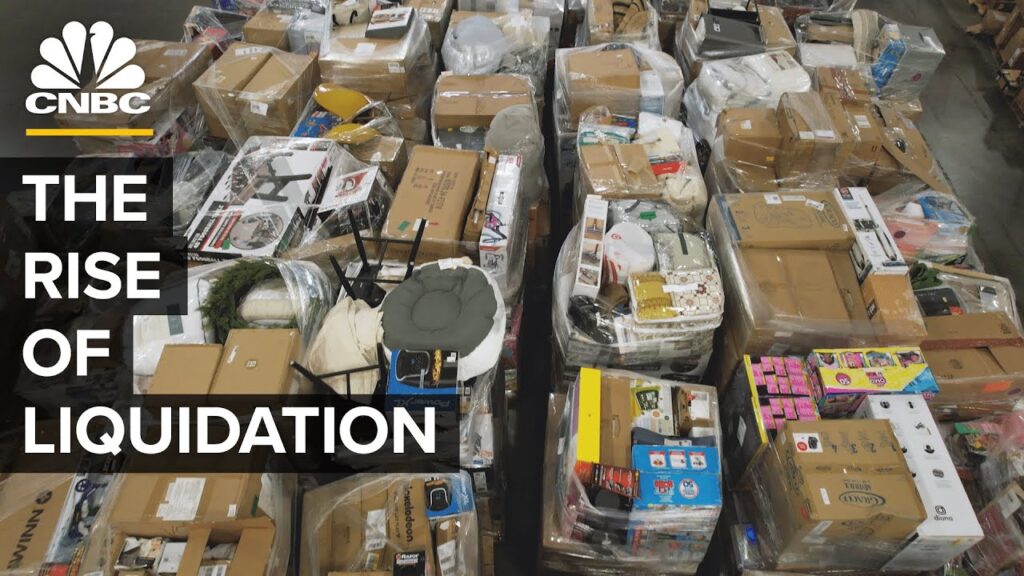A record number of online returns has created a booming $644 billion liquidation market. As supply chain backlogs cause shortages of new goods and Gen Z shoppers demand more sustainable retail options, pain points for one sector of retail are big business for another.
The nation’s only major public liquidator, Liquidity Services, resells unclaimed mail, items left at TSA checkpoints, and outdated military vehicles. It also refurbishes highly sought after electronics, from noise-canceling headphones to the machines that make microchips.
CNBC takes you on an exclusive tour inside a Liquidity Services returns warehouse outside Dallas, Texas, where unwanted goods from Amazon and Target are stacked to the ceiling before being resold on Liquidation.com or a variety of other marketplaces.
Inside Liquidity Services’ 130,000-square-foot warehouse in Garland, Texas, the aisles aren’t lined with typical merchandise. Instead, they’re stacked with returns from Amazon, Target, Sony, Home Depot, Wayfair and more, all in the process of being liquidated.
“Liquidators are coming in and they’re buying up all of this product in bulk. They’re then packaging it, palletizing it and reselling it, either to be resold on a site like eBay or Poshmark, or even to individual consumers. So it’s turned into a much bigger portion of the industry than we’ve ever seen before,” said Sonia Lapinsky of consulting group AlixPartners.
The liquidation market has more than doubled since 2008, reaching a whopping $644 billion in 2020, according to data from Colorado State University.
“A lot of this used to be controlled by the mafia,” said Zac Rogers, assistant professor of supply chain management at Colorado State University. “It’s a good way to hide money, honestly, because nobody’s looking at returns. Especially 40 years ago, no one was looking at returns.”
But in 2021, a record 16.6% of all merchandise sold was returned, up from 10.6% in 2020, according to the National Retail Federation. For online purchases, the average rate of return was even higher, at 20.8%, up from 18% in 2020. Processing a return can cost retailers up to 66% of an item’s original price, according to returns solution company Optoro.
“Everyone’s very worried about price increases right now. I would suggest that it’s possible part of the inflation is these huge amount of returns, that have to be sold at a loss, is detracting from the profitability that a company normally has, and they have to raise their prices,” said Tony Sciarrotta, executive director of the Reverse Logistics Association.
There’s also a big environmental cost. Returns that aren’t liquidated are often destroyed by being incinerated or sent to landfills. Optoro estimates U.S. returns generate an estimated 16 million metric tons of carbon emissions and create up to 5.8 billion pounds of landfill waste each year.
This pain point for mainstream retailers is now big business for liquidators. There are now thousands of companies in the booming space. One of them is GoodBuy Gear, which specializes in safely liquidating items for babies and young kids.
“Buying one used item, it saves 82% of its carbon footprint and consumers are really starting to make smart choices. And so I think that the boom in liquidation is really fueled by consumerism and how it’s shifted from new to used,” said Kristin Langenfeld, CEO and co-founder of GoodBuy Gear.
Sustainable shopping options are a growing priority for younger shoppers.
“The circular economy exists to make sure these items find a home, connect it with a family or a young consumer, and keep it out of the landfill,” said Bill Angrick, CEO of Liquidity Services. He co-founded the company in 1999 as Liquidation.com, with $100,000 of his savings.
“My father and I used to pick up used books and recyclable bottles. Fast forward to the start of eBay. My father and I started toying around with that. We realized that a marketplace model can create value for virtually any type of used item,” Angrick said.
Watch the video for an exclusive tour inside a Liquidity Services warehouse, to see the booming business of processing and reselling excess and unwanted goods on the secondary market.
» Subscribe to CNBC: https://cnb.cx/SubscribeCNBC
» Subscribe to CNBC TV: https://cnb.cx/SubscribeCNBCtelevision
About CNBC: From ‘Wall Street’ to ‘Main Street’ to award winning original documentaries and Reality TV series, CNBC has you covered. Experience special sneak peeks of your favorite shows, exclusive video and more.
Connect with CNBC News Online
Get the latest news: https://www.cnbc.com/
Follow CNBC on LinkedIn: https://cnb.cx/LinkedInCNBC
Follow CNBC News on Facebook: https://cnb.cx/LikeCNBC
Follow CNBC News on Twitter: https://cnb.cx/FollowCNBC
Follow CNBC News on Instagram: https://cnb.cx/InstagramCNBC
#CNBC
How Liquidating Unwanted Goods Became A $644 Billion Business
source
